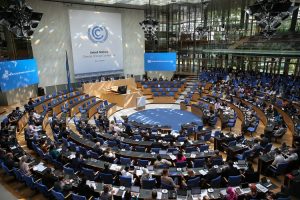The topic I selected from the United Nations Framework Convention on Climate Change’s (UNFCCC) interactive site, was the negotiations section. This section interested me because I think it is increasingly important to understand how to negotiate and solve problems fairly when multiple nations are involved with the agreements of the UNFCCC, including the Kyoto Protocol and the Paris Agreement. I have been particularly interested in the controversy among demands on developing countries to also lower their emissions, when they have historically had very low emissions and are trying to develop and grow their nation. The website explains that the UN Climate Conferences are where most of the discussions occur surrounding climate change, but there are also several negotiating bodies that they’re broken up into. The groups listed include: Conference of the Parties (COP), the Conference of the Parties serving as the meeting of the Parties to the Paris Agreement (CMA) and the Conference of the Parties serving as the meeting of the Parties to the Kyoto Protocol (CMP). The main goals of these conferences are to review progress in the Kyoto Protocol and the Paris Agreement, to make sure that all agreements are being followed, and they also may bring up new legislation (UNFCCC 2014). The conferences are typically two weeks long and happen once a year; this includes things like workshops and preparation meetings. Agendas are also set before the conference meetings occur to give some order and ranking to things that will be discussed. IGOs, NGOs, bodies and agencies of the UN, as well as the press and media are just some of the groups of people that attend the conferences. Within those groups there are four “forums” for negotiating including: plenary meetings, contact groups, informal consultations, drafting groups, and consultations by presiding officers (UNFCCC 2014). One thing that seems to help the UNFCCC in the negotiation process is the rules set out for the negotiation and the conference guidelines in general, known as the rules of procedure. Another aspect of the conference is transparency, which is seen especially in the negotiations. There were previously instances where separate negotiations were occurring among officers in closed meetings, however the UNFCCC felt that this exclusivity from possible agreements did not fit with their mission so officers are no longer allowed to have negotiating groups of their own (UNFCCC 2014). Negotiating might be one of the most crucial part in the discussion on climate change; legislation is passed and agreements are made because of these conferences. The system that the UNFCCC operates under for negotiating, within their conferences, also holds nations accountable for the agreements they made. The system operates to keep others in check to ensure that actual progress will be made. I would be interested in learning how the UNFCCCs strategies for negotiation could be applied to political matters, and how these agreements manage to subvert political disagreements that typically hinder progress, although there are coalitions formed based on politics within the conferences. I also would be interested in knowing more about how they treat unpopular opinions, or if there is any sort of hierarchy within the negotiation process that could give some bias in decisions.
Citations:
“Conference Essentials.” United Nations Framework Convention on Climate Change, UNFCCC, 18 Nov. 2015, unfccc.int/essential_background/bare_essentials/items/6145.php. Accessed 29 Aug. 2017.
Conference of the Parties. “Adoption of Rules of Procedure.” United Nations Framework Convention on Climate Change , 22 May 1996, pp. 1–16.
“Negotiations.” UNFCCC eHandbook , United Nations Framework Convention on Climate Change, 2014, bigpicture.unfccc.int/. Accessed 29 Aug. 2017.

